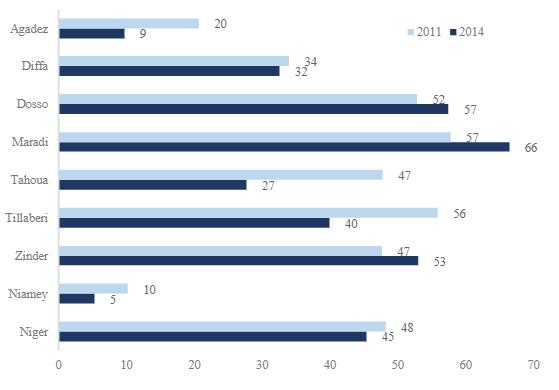
17 minute read
2. Niger policy for youth inclusion: institutional and community perspectives
In this section, we briefly present the perceptions of institutional actors recorded during the ECRIS (2019), focusing on the strengths and weaknesses of policy on youth entrepreneurship in Niger. We compare these with the perceptions of long-term resident community actors and from gender-disaggregated focus group discussions on the impact of government policy, more generally, on youth employment and welfare. In addition to the summary presented below, details on existing national policies are laid out in Annex A and on institutional and community perspectives in Annex B.
Youth policy on entrepreneurship: perceptions of institutional actors
Advertisement
We interviewed officials we met during the ECRIS, asking them how past and present youth policy provisions had evolved and about challenges to their implementation. Institutional actors spoke of a series of policies established in recent decades on employment, population growth, health, education and training, all of which influenced the socioeconomic conditions of the youth. These interviews and supporting documentation reveal a policy focus on youth and on entrepreneurship as a mechanism for change(see Annex A).
First, we note that current employment policies are more focused on the needs of young
people compared to previous decades, during which ‘they were approached in a generic way’ as underlined by a member of the Ministry of Youth Entrepreneurship, who added, ‘[n]owadays policies are focused toward young people and their improvement’. Notably, there are policies targeting children's rights, girls and women's health, family planning and women's rights. Initiatives also involve education (see Annex A), agriculture, the environment and climate change (soil recovery, agricultural inputs, development of market gardening, breeding) as well as entrepreneurship. On the latter, current policies emphasise entrepreneurship in particular by promoting self-employment, which it was argued should generate more jobs for young people and ‘thus mark the youth’s own responsibility in increasing their economic agency and achieving their development goals’. This could imply a form of neo-liberal policymaking, leaning towards greater self-responsibility of the policy recipient with a limited institution-led policy framework applied.
Second, whilst institutional actors emphasised that there is a real political commitment to youth at the state level, they also deplored the lack of financial and other resources being mobilised to support these policies. Reflecting these conditions, Nigeris low down in the league table of tax-to-GDP ratios and state revenues have only slowly increased over time (IMF, 2019). According to an official from the Ministry of Employment, Labour and Social Security, governments often make statements followed by weak actions. In fact, financial resources to support youth policies come mostly from external aid rather than internal
funding. Moreover, an analysis of policy documents reveals the plurality of ministries involved in pro-youth initiatives, bringing with it problems of coordination. One of the objectives of the Ministry of Entrepreneurship, established in 2016, was to centralise resources and actions undertaken, but the Ministry not yet been able to resolve these problems. For example, a concern raised within the Ministry by one of its members is that ‘we risk having double statistics’. In addition, we observe the obsolescence of services and the geographic dispersal of their locations across the capital.
Decline in developmental state interventions: perceptions of community actors The structure of political relations in the village and in the city often makes use of sponsorship and clientelism to manage decision-making processes in Tahoua and
Zinder. Across Niger, various modes of governance coexist and the state has difficulties in occupying its legitimate place in the development process, in both rural and urban areas. In urban municipalities, the presence of the state and its governance is visible through the availability of several technical services.
Figure 1. Summary of respondent perceptions on regime periods

• Focused on extent to which Hamani
Diori (1960–1974)and
Seyni Kountché (1974–1987) invested in rural
infrastructure (health, education, water) and institutional agricultural
support: e.g. ‘[Kountché period] is the best time people can remember’ particularly in terms of support for farming…
Agricultural (extension) officers used to go to the fields to ask about the agricultural situation... The inhabitants benefited from plots of land at affordable prices’ (FG, mixed, Dogo).

• Relatively better
educational quality and civil service
employment: ‘Obtaining a graduation certificate made it possible to be recruited’ (FG, mixed,
Dogo).

Pre-structural adjustment developmental state
(1960 to late 1990s)
Liberalised welfare state –Tandja
(1999 –2010)

• Few/no charges in education and health:
‘Under Tandjachildren under the age of 5 and pregnant women were treated free of charge in health centres’(FG, mixed, KaraKara).
• Safer migrant employment opportunities: ‘It was easier for young migrants to first go to
Libya and work with respect’.
• Training opportunities: ‘Under Tandja, there were training centres for weaving, sewing and masonry. These continued under Issoufou, but it was mainly young men who did not benefit enough in terms of employment during the regime of President Issoufou Mahamadou’ (FG,
Mixed, Bambaye).
• Some decline in state agriculture support for
extension inputs, rising costs of land, some
support for struggling farmers: ‘Under Tandja, rural populations were supported through the distribution of goats. …. For women, there is multifaceted support for women’s groups: grain mills, provision of small ruminants for fattening and for the reconstitution of livestock capital, credit for conducting income-generating activities [IGAs]’ (FG, mixed, Gueben Zogui). • Stronger focus on women's empowerment (driven by the state's reliance on NGOs/donors).
• Electrification(but problems of privatisation): ‘[Inhabitants] are able to do new activities related to electricity such as selling fresh water, ice, metal welding, sellingconstruction materials, etc.’ (FG, mixed,
Bambaye).
• New government fees: ‘Life is becoming more and more expensive.
Even for free services (free health care, distribution of supplies at school, civil status documents) you have to pay money’(FG, mixed,
KaraKara).
• Decline in recruitment of local youth to civil service jobs in education, health and police, and allegations of corruption: ‘No young people from the neighbourhood were recruited into the civil service. According to them, if you are not an activist in a political party that is in power, you cannot be recruited’(FG, male, Karakara).
• Riskier migration:‘Young people who are now in Libya live in secrecy and fear because of the war situation. They are holed up in houses and can no longer go out even to send money to their families’(FG, male,
Gueben Zogui).
• Declines in farm size, limited ability to afford new land, expensive fertiliser, leading to forced entrepreneurship: ‘In the context of soil degradation, production is increasingly declining. To boost it, this requires the application of fertilizer. This requires large sums of money that are beyond the capacity of the majority of the population’ (FG, l D )
Intensified liberalisation/ privatisation –Issoufou (2010–2020)
On the other hand, these services are subject to structural problems linked to insufficient financial and human resources, under pressure from the weight of local political power games, and subject to clientelist practices3in the procurement of public contracts and the appointment of civil servants. In rural communities, despite the advent of democratisation and decentralisation, we observe a decline in public services and the absence of the state. In contrast, there has been an accentuated rise in the power of national NGOs working as subcontractors for I-NGOs or other development actors. In both rural and urban environments in Tahoua and Zinder, the practice of sponsorship is predominant, provided by locals who have made their fortune or career either in town or through international migration to coastal countries in the region. With decentralisation, the canton chiefdom has been deprived of some of its powers in favour of the mayors, although it retains strong symbolic and political powers in the rural world. We can therefore observe that decisionmaking and governance practices are characterised more by a clientele-sponsorship model than a participatory model.4
Focus groups in Zinder and Tahoua also commented on the role of state intervention under different political regimes since independence (see Figure 1 for a summary and Annex B). They spoke ofdeclining stateintervention in agriculture over time, rising costs of access to education and health, and reduced recruitment of local youth in salaried public sector jobs. This has led to limited poverty reduction in the country as a whole (Figure 2). Although efforts have been ongoing for service delivery improvement as well as for the decentralisation of financing sectors like education5, in-depth discussions indicated that these have coincided with economic, climatic and demographic pressure on youth endowments of farm and water resource depletion. These triggers are coupled to competitive employment prospects, rising real costs of living and of productive assets, and poor educational endowments, as elaborated in Sections 3 and 4. These intersect to challenge youth inclusion in labour markets in Niger. In Section 3, we focus on three specific drivers of youth inclusion – education and training, youth livelihoods and changing gender
3 Olivier de Sardan (2004) underlines that ‘the recent generalization of a multiparty system has grafted [in addition] an immense and omnipresent system of partisan preferences, from the top to the bottom of the state apparatus: electoral clientelism - and its postelectoral and pre-electoral fallout [18] -has superimposed itself over other pre-existing forms of clientelism’ (p.6; authors translation). 4 Although participatory and inclusive models for decisionmaking are an increasingly recurrent narrative used in the development practice and NGO world, positing that local actors should have a say in decision-making and in the management of public actions, this is not a reality for Niger in practice. Moreover, the participatory model for decision-making comes up against three major criticisms: (1) the centralist and authoritarian model remains largely dominant; (2) local actors are only invited to participate on minor and secondary points of discussion; (3) in villages and neighbourhoods, participation in fact covers many
games of power and influence, such as the so-called ‘elite capture’ phenomena (Chauveau, 1994). 5 As example of decentralisation of resources the National
Agency for the Financing of Local Authorities (ANFICT), created in 2014, has an education desk since 2018 which allows funding to regions for secondary education and to municipalities for primary education. Funds are used for i)constructing establishments, ii) buying equipment and iii)providing grants to school management committees like the CGDES (Comités de Gestion Décentralisée des
Etablissements Scolaires) for primary schools and COGES (Comité de Gestion des Etablissements Scolaires) for secondary schools. The grants to CGDES and COGES are today the only source of government funding arriving directly to schools and managed by schools to finance part of the plans to improve quality of education and setup action plans for preparedness, crisis management and response.
and generational norms – which provide context for our findings on poverty mobility in Section 4.
Figure 2. Poverty incidence in 2011 and 2014 (%)

Source: World Bank (2017).
3. Context today –key drivers of beneficial inclusion: education, types and quality of livelihoods, and generational and gender norms
Summary: Quality of education, quality of livelihoods, and changes in gender and generational norms each shape the quality of youth inclusion in labour markets and poverty dynamics. The education of youth varies across public education, Quranic education, training tracks and combinations of them. At national level and in Tahoua and Zinder, state school attendance is higher for youth than older generations and for young men compared to young women. However, a main barrier to accessing education in both Tahoua and Zinder is reported to be the overall school fees collected at school level – for secondary schooling along with those of the Comité de Gestion des Etablissements Scolaires (COGES), which hamper retention of the poorest youth in particular. Public schooling in the two regions also has reduced retention due to infrastructure and teaching quality issues as well as, for the poorest, long distances to school, issues of hunger and humiliation linked to inability to cover costs. Quranic education is seen an important site for continued education in Tahoua and Zinder, particularly in the event of dropping out of state school. In the quantitative data, however, the shares of individuals recorded as having attended Quranic education are lower among youth compared to other adults (except for those in impoverished households).
Training or apprenticeships are another mode of learning availablein Tahoua and Zinder, but training in the form of second chance education encounters serious limitations with financing. NGOs play a major role in the offering of activities, but there is a distinct bias in the selection of candidates for training that disproportionately benefits those with a certain level of education or stronger social networks, thus excluding the poorest and often women due to the funding or programme structure. Moreover, the main limitation of these educational means is inefficiency in supporting the start-up of or ensuring the continuity of an activity, which acts as real barriers to achieving the effective labour market inclusion of youth.
With low educational endowments and facing rising costs of services and basic needs with no coordinated government support to lay the foundations for improved welfare, youth may be stuck in farming or driven to find niches in a precarious local labour market, on weak terms and without capital to invest in trade. Rural youth engage in on-and off-farm day work or self-employment, and display a higher incidence of impoverishment than those in urban areas. Urban non-farm wage labour and business (rather than petty trade) are stronger. Migration – either internal wage labour migration or working in retail abroad –is observed from both areas too. However, the risks involved mean that many who migrate fall back into poverty, while other (often chronically poor) individuals are unable to find the start-up capital for migration in the first place.
The fortunes of young men and women in Niger are differently determined, but intertwined, in a context of significant changes in social norms and precariousness of occupations and the kinds of job opportunities they have access to. In Tahoua and Zinder, the need for income and involvement in new livelihoods thrusts youth into conflict with elders and spouses, which forces rapid changes in gender and generational norms to accommodate the new and difficult circumstances. Young women more often actively seek training and job opportunities at growing rates, and it is becoming more accepted by young generations that it is not only women who are experiencing the strongest economic hardship
that seek work. However, there are exceptions in other areas of the country or in some fundamentalist households in the middle class. In Tahoua and Zinder, male youth groups act as a support mechanism for finding work and solving daily hardships. They also organise and mobilise labour for community support to deal with health and water problems within the neighbourhood. A financial support function is provided by informal credit groups or formal tontines for women, enabling inclusion amidst pathways out of poverty.
To contextualise the study areas and better gauge our analyses of the next sub-sections on livelihoods, inclusion pathways and poverty, we briefly report some main characteristics of socio-normative practices, spanning religion to intra-household relationships.
In terms ofreligious composition, the populations of the Zinder and Tahoua regions are, like the whole country, predominantly Muslim (99%) followed by a minority of Christians (0.8%). The Muslim faiths practiced are rather diversified and segmented, but two main currents characterise the schools of faith followed. The first is the longstanding establishment of the Sufi brotherhoods: the Tijaniyya (still present in the regions) and the Quadriyya (formerly a predominant current, but today residual). The second current a fundamentalist one, with the Izala (of Nigerian origin) the main movement in the expansion of the last 20 years, but also accompanied by various other sects. The fundamentalist current’s 20-year expansion is associated with young people returning from international migration to heavily Islamised areas, mainly northern Nigeria and Libya, which has contributed to the rapid growth in rural areas of the practice of more rigid forms of Islam. The Sufi brotherhoods are considered ‘moderate’ and tolerant currents, whereas the Izalais seen as an ‘intolerant Salafist’ current (Douada Hainikoye, 2015). Under the Izalists’ influence, the practice of wearing a veil has become generalised among women, while the seclusion of women at home is growing in some areas (such as the Maradi region) or among some groups, but without becoming a major practice. There is a relevant presence of religious schooling, and particularly of Quranic education, among the educational and communal activities practiced in the country; see Dia et al. (2021) for an analysis in the Sahel region and Assane Igodoe and Salao (2021) for its characteristics in Niger.
The standards for regulating marriage unions and intergenerational relations have been changing in the last two decades. Particularly through the influence of the Izala movement, today it is common to reconsider the practice of marriage compensation – which is being reduced to a minimum, if not disappearing from common practice – or to denounce the tyranny of the elders over younger kinship (Meunier, 1998; Sounaye, 2016). Polygamy – in which men are legitimised by Islam to marry up to four women –is the customary marriage regime. It concerns around 20% of married men and one-third of married women (Harouna, 2008) and it is more common in rural than in urban areas. A variety of multifaceted sociocultural and economic factors accompany religiosity as the norms regulating intra-marital relations in polygamous households. For instance, highly educated individuals are more likely to be either monogamous or bigamous and have fewer children, and this trend
concerns women more than men. For men, the more wives they can provide for, the more they earn in terms of social prestige. Particularly in rural areas, polygamy is combined with a high birth rate to promote the economic and social status of the household through the domestic and agricultural work of household members (Najoum, 2020), but this is not without its issues. Due to the scarcity of resources and the precariousness of the labour market, there is a generalisation of the formation of intra-household maternal microeconomies, where each wife of the household and her children live in isolation with their own income (Nguimfack, 2014). Rivalries (sexual, reproductive, economic and domestic) between co-wives, as well as conflicts between their respective children, are widespread in Niger and have important social repercussions (Olivier de Sardan, 2017), a finding which is also visible widely across West Africa (Fainzang and Journet, 1988). Nevertheless, certain forms of female solidarity may emerge and some women find in their status as co-wife a reduction in their obligations towards their husband.
With respect to the distribution of tasks, budgets and decision-making within Nigerien households, no matter the environment (rural or urban) or the couple’s age group (young or older), men are typically expected to be responsible for all expenses related to household needs: accommodation, basic food, minimum clothing, health expenses and school expenses. The main male revenue-generating activities in rural areas are in agriculture, livestock and commerce. This notion is widely accepted in the literature for Niger, and our interlocutors during the FGDs in the two regions confirmed this acquired knowledge. Women are responsible for domestic tasks and generally earn through the breeding of small ruminants, the sale of cooked meals or condiments, the sale of market gardeners’ products cultivated, or other small businesses such as the sale of mats. They also manage their own capital (livestock, furniture, land). However, these norms are beginning to change, as discussed below.
In rural areas, depending on the farm-household situation, agricultural and livestock activities may rank first or second in order of relevance. Collective field farming, where several generations work together, is increasingly rare, although we see an exception in Dogo (Zinder), where the family field is the site of collective work and the harvests are shared between the members of the family, but trade is the main source of income for our interlocutor (LH, male, Dogo). Men are primarily responsible for agricultural work and hold the majority of the land, but they are helped in certain tasks by women, who may also have a plot of land where they can produce crops for the household or for their own needs (e.g. sale of surplus to buy clothes or participating in social events). These aspects are discussed in Section 2.2. In this patriarchal system, the last word on important decisions concerning the family (recourse to health care, schooling, migration, etc.) generally belongs to the man.6
6 ‘Despite the diversity of their beliefs and practices, the ethnic groups in Niger share the same differentiated perception of male and female roles. In all these groups, family relations between men and women are built on the basis of a fundamental inequality between the man, head



